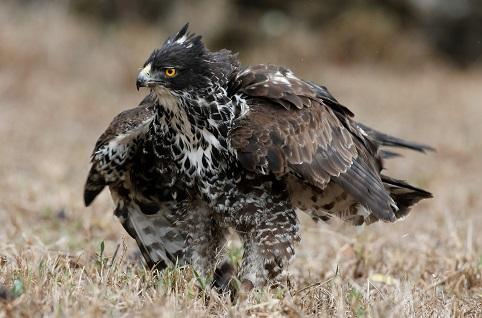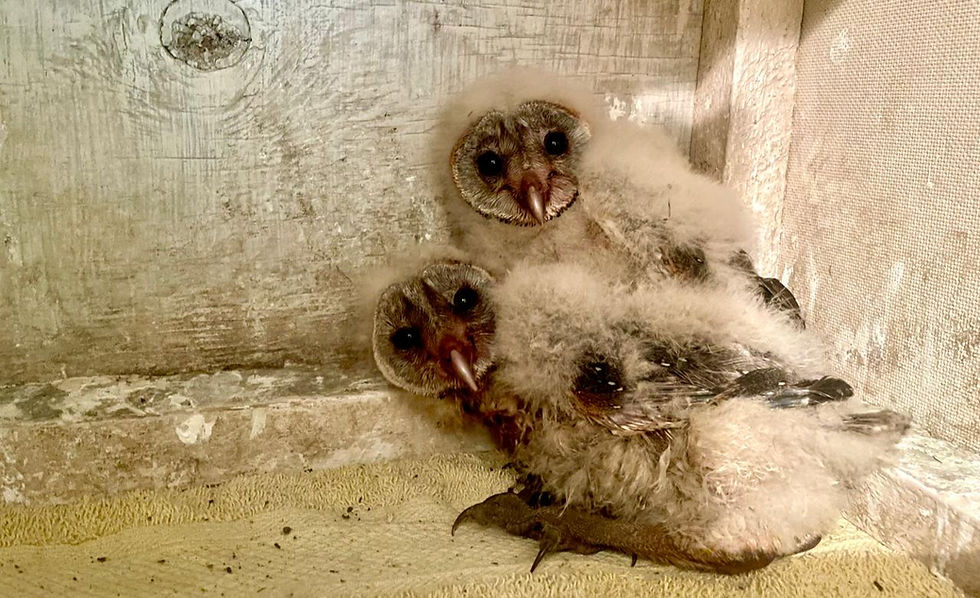Jane, the rehab Ayres’s Hawk Eagle
- Simon Thomsett

- Mar 5, 2022
- 4 min read
It’s the 29th Jan 2022 and I feel as though I am writing from the future. Standing next to me, with one leg drawn up into her fluffed up feathers, is a gorgeous adult female Ayres’s Hawk Eagle. Yesterday she was feeding happily on my glove outside looking at the hills around. She roused and preened for the first time on the glove and is obviously so very relieved to be alive. She was brought in to the Naivasha Raptor Centre on the 10th Jan 2021 from the site of our former centre owned by the late Sarah Higgins by Jared the accountant who knew us.

10 Jan 2021 The moment she was found on a path and lucky to encounter people we know.
I tore off down the road to fetch it as Shiv happened to be away and on inspection noted it had deep cuts in the muscles between the radius and ulna (the pronator longus and the extensor carpi radialis) and the debridement of dead tissue required removal of 25% of one or two of these muscles. A large section of skin, about the size of two coins, was missing and the patagium was bruised and the radius fractured.
11 Jan 2021, the Ayres’s Hawk Eagle left wing after having been cleaned up. Unseen is a leading edge abrasion on the patagial tendon. 4 days after this photo the skin around the radius turned green showing it had suffered injury but was healing well.
She had hit an unyielding thin object head on, probably a fence or power line. At least it was not an electrocution, now the most common form of delayed injury with the least chance of recovery. Patching her up was straight forward...no need for a surgical solution for the radius as the ulna held it in place. She needed fluids, force feeding for a surprisingly long period of six days before being able to eat on her own. But now, just over 2 weeks on, she is happy and feeds on the hand. Some may contest this management but she will get priority treatment and her flight will be assessed before her release. Few raptors on earth require so thorough a prior assessment.
Jane is going through the steps needed in properly rehabilitating a broken wing. Just like humans they must build up strength, realign bone, muscle, tendons and relearn how to accommodate for the injury. On the left she is learning to fly to the glove and lure...hundreds of metres beyond the meagre confines of a large shed. On the right she is “rousing” while sitting on the lure...an evidently happy eagle.
I can’t take my eyes off her because she is so gorgeous. I endeavour, honestly, to be an “under the hood kind of guy” and not interested in the cosmetic paint job. Read the book, don’t look at the cover. Etc. But I fall hopelessly in this case for her looks. I struggle to oppose it and seek a scientific explanation, searching TED talks on the evolutionary advantage of beauty for beauty’s sake in birds and cross species appreciation of “beauty”. Does a Chital deer appreciate the stunning beauty of a tiger? Does it delay that one second too long? Humans do. Ask any survivor. I like where this is going, because there is a link between fast lifestyles and what we perceive as beauty in raptors and carnivores. Plain looking raptors, especially in the tropics, tend to have bland lives. I can think of no end of examples but this is going off topic.
In being obliged to clean her wing frequently (the flies are a very real threat recently), I am able to appreciate the larger stronger carpal bones and affirm a robust alula. Her feet are more massive than I had remembered, and when placed next to the exceptionally big young female Black Sparrowhawk, who is quite capable of taking full grown guineafowl should she care to, Jane’s foot has at least 3 times the volume. She is also as quick as lighting...faster than the sparrowhawk with a much longer reach...and that is saying a lot. So, as the days tick by, Jane (as in Jane Eyre) is improving and getting trained up gently for one day soon we will have to rehabilitate the use of her damaged wing. My friend the late Ron Hartley long ago rehabilitated a male and female Ayres’s Hawk Eagle, given to him by those that knew cage management just was not suitable for so demanding a bird. He had difficulty with them as did I with one brief liaison many years ago. They demand full attention and the very best care and adherence to detail. Like those before her she is very hard work. Constantly moving and thrashing against enclosure walls, the second I removed her bandages I conceded that she was only manageable when on the glove...pampered, feeding or hooded. I left her one minute today on a bow perch, unhooded, to screw off the base of my coffee maker and she had bent one primary...a disgrace for any rehabber and unless fixed immediately a genuine problem that could lead to a cascade of broken feathers.
Though it will take an enormous amount of time and draw me away from the tedium of other work I can think of no better excuse. She has brought back to me the memories of when I was young and when eagles were on every hill.
Wish to learn more, visit our website and join us on Facebook and Instagram.
Kenya Bird of Prey Trust
Understand - Protect - Restore














Wonderful story Thomsett: thank you !